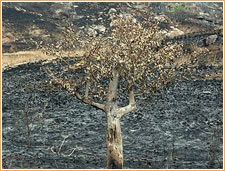Home Human Impact
 |
 |
 |
| Slash and burn agriculture is taking its toil on the island's last remaining old-growth forests. |
|
People first arrived on the island around 300 BCE, which is relatively recent in the history of human migration and civilization. Homo sapiens arrived in Europe tens of thousand of years ago. By the time the first settlers successfully paddled or sailed to Madagascar, the Great Pyramid of Giza was already ancient.
The relatively recent arrival of our species on the island makes it an important laboratory for studying how humans' affect pristine ecosystems.
When the newcomers arrived, Madagascar was covered with forests and savannah-like grasslands, and home to an impressive array of creatures: gorilla-sized lemurs hid in the woods, pygmy hippopotamuses wallowed in rivers and 10-foot-tall flightless birds laid cantaloupe-sized eggs.
These and other large animals -- what scientists call "megafauna" -- became extinct a long time ago. Why? There is much speculation, but marks on fossilized bones suggest humans hunted the animals -- possibly to the point of oblivion.
But biologist David Burney, one of the scientists interviewed by Dan Grossman, is after hard evidence. For close to 20 years Burney has sought to uncover humanity's role in the great extinction. In this section you can view photographs of one of his most recent fossil expeditions to the island. You will see a variety of photographs of animal fossils of different shapes and size, including a prodigious collection of bones from extinct lemurs.
If humanity's responsibility for the end of the megafauna remains in doubt, there is no uncertainty regarding the part people played in the deforestation of the island. During the last 50 years Madagascar has lost over 90 percent of its forests. In the past, the culprits were lumber companies and large plantations. Today, deforestation is caused primarily by the island's many poor farmers.
A common technique used by the farmers is to fell the trees and then burn the stumps and undergrowth. You will see photographs that depict the ruinous progression of this "slash and burn" approach to agriculture, including glimpses of the end result -- eroded moonscapes.
Begin your exploration of how the Island 's people have altered its ecology -- past and present -- by clicking on the links below:
|

